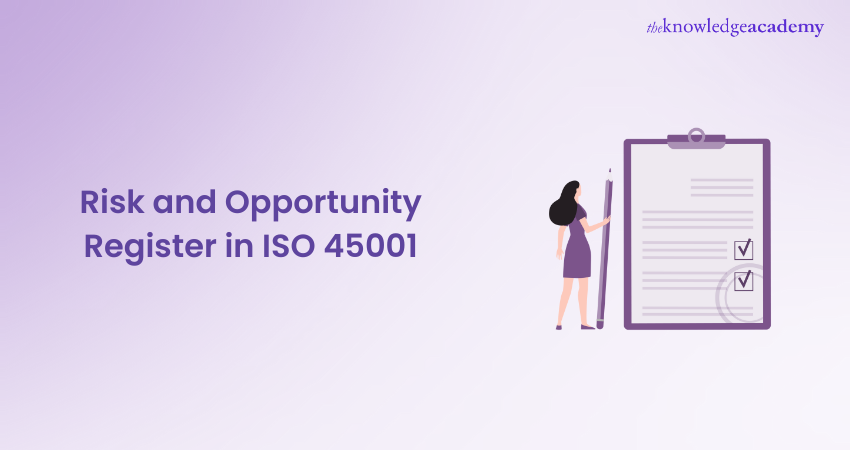We may not have the course you’re looking for. If you enquire or give us a call on +44 1344 203 999 and speak to our training experts, we may still be able to help with your training requirements.
We ensure quality, budget-alignment, and timely delivery by our expert instructors.

ISO 45001 is the globally recognised Occupational Health and Safety Management Systems (OHSMS) standard. The standard is known for providing a framework for organisations to address risks and opportunities in their operations effectively. One of the key tools in ISO 45001 is the Risk and Opportunity Register, which plays a crucial role in managing and mitigating risks while maximising potential opportunities. This blog will tell you all you need to know about a Risk and Opportunity Register in ISO 45001, how to create it, and its benefits.
Table of Contents
1) What is a Risk and Opportunity Register in ISO 45001?
a) Definition and purpose
b) Key elements of the register
2) Creating an effective Risk and Opportunity Register in ISO 45001
a) Step 1: Identify and assess risks
b) Step 2: Identify and assess opportunities
c) Step 3: Assign responsibilities
d) Step 4: Develop risk treatment plans
e) Step 5: Monitor and review
3) Conclusion
What is a Risk and Opportunity Register in ISO 45001?
This section of the blog will tell you all you need to know about a Risk and Opportunity Register.
Definition and purpose
The Risk & Opportunity Register is a structured tool used to systematically identify, evaluate, and manage risks and opportunities within an organisation. It serves as a centralised repository for recording and tracking all identified risks and opportunities, ensuring they are adequately addressed and monitored over time. The register facilitates proactive decision-making, enabling organisations to allocate resources effectively and prioritise actions based on the level of risk or potential benefits.
Key elements of the register
A comprehensive Risk & Opportunity Register typically includes the following key elements:
1) Risk and opportunity description: A clear and concise description of each identified risk or opportunity, including relevant details such as its nature, potential consequences, and associated stakeholders.
2) Risk likelihood and impact assessment: An evaluation of the likelihood of the risk occurring and the potential impact it may have on the organisation if it materialises. Similarly, opportunities should be assessed for their likelihood of occurrence and potential positive impact.
3) Risk and opportunity rating: A numerical or qualitative rating that represents the level of risk or opportunity, often based on a combination of likelihood and impact assessments. This rating helps prioritise actions and allocate resources accordingly.
4) Risk treatment plan: A documented plan outlining the actions to be taken to mitigate or eliminate the identified risks, as well as strategies to capitalise on the identified opportunities. The plan should specify responsible parties, timelines, and required resources.
5) Monitoring and review mechanism: A process for regularly monitoring the effectiveness of risk treatments and reviewing the status of identified risks and opportunities. This ensures that the register remains current and aligns with the organisation's evolving needs.
Take the next step in advancing your occupational health and safety career with our ISO 45001 courses - explore now!
Creating an effective Risk and Opportunity Register in ISO 45001
To create an effective Risk & Opportunity Register, organisations should follow a structured approach that incorporates the following steps:

Step 1: Identify and assess risks
The first step involves identifying potential risks by conducting thorough hazard assessments, considering both internal and external factors. Organisations should involve relevant stakeholders to ensure a comprehensive identification process. Once the risks are identified, they need to be assessed for their likelihood and potential impact on the organisation.
Step 2: Identify and assess opportunities
In addition to risks, organisations should also actively seek opportunities to improve their occupational health and safety performance. Opportunities can arise from technological advancements, industry best practices, or changes in regulatory requirements. Similar to risks, opportunities should be assessed for their likelihood and potential positive impact.
Step 3: Assign responsibilities
Assigning clear ownership and responsibility for each identified risk and opportunity is crucial for effective management. By assigning responsibilities, organisations ensure that actions are taken to address the risks and capitalise on opportunities. This step helps avoid confusion and ensures accountability.
Step 4: Develop risk treatment plans
Organisations should develop comprehensive risk treatment plans based on the identified risks and opportunities. These plans outline specific actions, timelines, required resources to mitigate or eliminate risks, and strategies to exploit opportunities. Risk treatment plans should be realistic, measurable, and aligned with the organisation's overall objectives.
Step 5: Monitor and review
The final step in creating an effective Risk & Opportunity Register is establishing a robust monitoring and review mechanism. Organisations should regularly assess the effectiveness of risk treatments, track the progress of identified risks and opportunities, and update the register as necessary. This ongoing monitoring and review process ensures that risks and opportunities are continually managed and aligned with the organisation's changing circumstances.
Level up your occupational health and safety skills with our ISO 45001 Foundation Course – sign up now!
Conclusion
All in all, the Risk and Opportunity Register in ISO 45001 is a powerful tool for organisations seeking to manage risks effectively and capitalise on opportunities in accordance with ISO 45001 requirements. By following a systematic approach and involving employees at all levels, organisations can create a culture of proactive risk management and continuous improvement.
Want to excel in occupational health and safety auditing? Sign up for our ISO 45001 Lead Auditor Course today!
Upcoming Health & Safety Resources Batches & Dates
Date
 ISO 45001 Foundation
ISO 45001 Foundation
Mon 10th Feb 2025
Mon 19th May 2025
Mon 8th Sep 2025
Mon 8th Dec 2025







 Top Rated Course
Top Rated Course



 If you wish to make any changes to your course, please
If you wish to make any changes to your course, please


